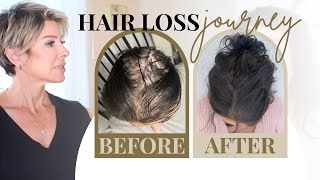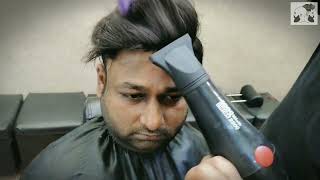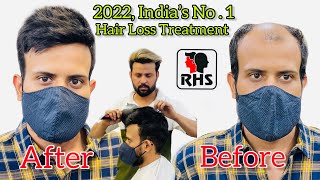What is Alopeica? And other forms of hairloss
- Posted on 02 November, 2021
- Hair Knowledge
- By Emma & Stuart
learning about ‘Alopecia'
 The term Alopecia is the most common term for hair loss. Even though there are many types of hair loss, all with different symptoms and causes. Alopecia causes one or more patches of hair loss and alopecia affects both genders.
The term Alopecia is the most common term for hair loss. Even though there are many types of hair loss, all with different symptoms and causes. Alopecia causes one or more patches of hair loss and alopecia affects both genders.
Do you have A TYPE OF HAIR LOSS? Read our alopecia guide to find out.
If you feel that we have missed anything of interest from the guide then please get in touch in the ‘comments section‘ below and we review your entry and credit you with the inclusion.
The guide is not to be copied in whole or any part in accordance with © Copyright, Simply Wigs Ltd. All rights reserved. But please feel free to link to this article as a reference.
Hair loss, also known as alopecia or baldness, refers to a loss of hair from part of the head or body. [a] Typically at least the head is involved. [b] The severity of hair loss can vary from a small area to the entire body. [c] Typically inflammation or scarring is not present.
Androgenetic Alopecia (AGA):
Also known as female/male pattern baldness. It is thought to be a hereditary form of hair loss and is the most common type of progressive hair loss.
Androgenetic alopecia is a very common type of progressive hair loss. It is a thinning of the hair to an almost transparent state, in both men or women. It affects about 50% of women over the age of 65 and about 50% of men over the age of 50. In women the severity varies, it may present as widespread hair thinning but in some rare cases it can lead to complete baldness.
What causes androgenetic alopecia?
Androgenetic alopecia is caused by a combination of genetic and hormonalfactors. Dihydrotestosterone (DHT) is the main hormone responsible for androgenetic alopecia in genetically susceptible individuals. DHT causesscalp hair loss by inducing a change in the hair follicles on the scalp. The hairs produced by the affected follicles become progressively smaller indiameter, shorter in length and lighter in colour until eventually the follicles shrink completely and stop producing hair.
Can androgenetic alopecia hereditary?
Yes. It is believed that genetic susceptibility to this condition can be inherited from either or both parents.
Alopecia Areata (AA):
It can occur at any age, but mostly affects teenagers and young adults. Alopecia areata causes patches of baldness about the size of a large coin. Alopecia Areata will usually appear on the scalp but it can also occur anywhere on the body. In most cases of alopecia areata, hair will grow back with in a few months. Alopecia areata is thought to be an autoimmune condition. This occurs when the immune system mistakenly attacks and destroys healthy body tissue. Some people with this condition have a family history of alopecia. Alopecia areata is seen in women, men and children. In a few people, hair loss may occur after a major life event such as an illness, pregnancy, or trauma.
Alopecia Barbae:
Alopecia barbae is alopecia areata that is localised to the beard area. It can be a single bald patch or more extensive hair loss across the whole of the beard area. Some studies indicate that the factors responsible for causing this condition may be heredity and/or autoimmune diseases; however, no evident reasons are identified yet. According to scientists, as alopecia barbae begins to affect our body start producing antibodies. These antibodies get collected in one patch and attack the hair follicles or cells causing hair loss. In some cases, stress, anxiety, and depression also contribute to accelerate the condition.
Anagen Effluvium:
Anagen effluvium is widespread hair loss that can affect your scalp, face and body. One of the most common causes of this type of hair loss is the cancer treatment chemotherapy. In some cases, other cancer treatments – including immunotherapy and radiotherapy – may also cause hair loss. The hair loss is usually noticeable within a few weeks of starting treatment. However, not all chemotherapy drugs cause hair loss and sometimes the hair loss is so small it's hardly noticeable. It may be possible to reduce hair loss from chemotherapy by wearing a special cap that keeps the scalp cool. However, scalp cooling is not always effective and not widely available.
In most cases, hair loss in anagen effluvium is temporary. Your hair should start to grow back a few months after chemotherapy has stopped.
Alopecia Totalis:
Alopecia Totalis is an auto-immune disorder which results in the total loss of hair, but only on the scalp. It is somewhat of an intermediary condition between Alopecia Areata which is patchy scalp hair loss. Alopecia Universalis extends to total body hair loss. This condition comes about as a result of an autoimmune disorder which causes your immune system to attack your hair follicles.
Alopecia Universalis (AU):
Alopecia universalis is the most advanced form of alopecia areata which results in total loss of all hair on the body, including eyelashes and eyebrows. It may also damage and distort nails. The condition is something that is present from birth, although may not present itself until later on in life. It is difficult to treat, although some sufferers do spontaneously have hair grow back, even years after the onset of the condition.
Cicatricial Alopecia
The cause of cicatricial alopecia is not well understood. What is known is that redness, heat, pain, or swelling occurs at the upper part of the hair follicle. That is the place where stem cells and sebaceous (oil) glands are located. Stem cells are cells that can develop into different kinds of cells. If the stem cells and oil glands are destroyed, the hair follicle cannot regrow, and hair is permanently lost. Sometimes it is known as another name for Scarring Alopecia
Scarring Alopecia
Scarring alopecia, also known as cicatricial alopecia, is usually caused by complications of another condition. In this type of alopecia, the hair follicle (the small hole in your skin that an individual hair grows out of) is completely destroyed. This means your hair won't grow back. Depending on the condition, the skin where the hair has fallen out is likely to be affected in some way.
Scarring alopecia occurs in both males and females, but is less common in children than adults. It accounts for about 7% of hair loss cases.
Telogen Effluvium
Telogen effluvium is a common type of alopecia where there is widespread thinning of the hair, rather than specific bald patches. Your hair may feel thinner, but you're unlikely to lose it all and your other body hair isn't usually affected.
Telogen effluvium can be caused by your body reacting to :
- hormonal changes, such as those that take place when a woman is pregnant
- intense emotional stress
- intense physical stress, such as childbirth
- a short-term illness, such as a severe infection or an operation
- a long-term illness, such as cancer or liver disease
- changes in your diet, such as crash dieting
- some medications, such as anticoagulants (medicines that reduce the ability of your blood to clot) or beta-blockers (used to treat a number of conditions, such as high blood pressure)
(Source: NHS Choices)
An autoimmune disorder develops when your immune system, which defends your body against disease, decides your healthy cells are foreign. As a result, your immune system attacks healthy cells. Depending on the type, an autoimmune disorder can affect one or many different types of body tissue. Alopecia being a type of an autoimmune disorder. It results in total hair loss on the scalp, and can affect eyebrows and eyelashes as well, but this is the extent of the condition. It does not cause thinning or shedding of any other form of body hair. However, Alopecia Totalis can affect nails as well as hair, causing them to become thin, brittle and ridged. Beyond hair loss, Alopecia Totalis has no physical side effects. It does not induce pain or sickness and the quality of life for sufferers is generally not affected, except by the psychological implications that accompany any form of hair loss. The condition is not contagious, but is thought to have a genetic influence, so there is an increased chance that sons and daughters could face the same issues.
Chemotherapy
In some cases, other cancer treatments – including immunotherapy and radiotherapy – may also cause hair loss. The hair loss is usually noticeable within a few weeks of starting treatment. However, not all chemotherapy drugs cause hair loss and sometimes the hair loss is so small it's hardly noticeable.
It may be possible to reduce hair loss from chemotherapy by wearing a special cap that keeps the scalp cool. However, scalp cooling is not always effective and not widely available.
In most cases, hair loss in anagen effluvium is temporary. Your hair should start to grow back a few months after chemotherapy has stopped.
Discoid Lupus:
A mild form of lupus affecting the skin, causing scaly marks and hair loss
Folliculitis Decalvans
A rare form of alopecia that most commonly affects men, causing baldness and scarring of the affected areas
Frontal Fibrosing Alopecia
A form of scarring hair loss affecting the hair margin on the front of the scalp. This happens due to inflammation and destruction of the hair follicles. There may also be hair loss around the ears and from the eyebrows. It most commonly occurs in women who have gone through menopause but can also occur in pre-menopausal women and, rarely, in men.
Immunotherapy
In some cases, other cancer treatments – including chemotherapy and radiotherapy – may also cause hair loss. The hair loss is usually noticeable within a few weeks of starting treatment. However, not all chemotherapy drugs cause hair loss and sometimes the hair loss is so small it's hardly noticeable.
It may be possible to reduce hair loss from chemotherapy by wearing a special cap that keeps the scalp cool. However, scalp cooling is not always effective and not widely available.
In most cases, hair loss in anagen effluvium is temporary. Your hair should start to grow back a few months after chemotherapy has stopped.
Lichen Planus
Lichen planus is a non-infectious, itchy rash that can affect many areas of the body including more commonly arms, legs and trunk areas but can also effect the mouth (oral lichen planus),
nails and scalp.
Lupus
A complex condition that affects many parts of the body. "lupus&" is most often used to describe a more severe form of the condition called systemic lupus erythematosus (SLE). However, there are several other types of lupus that just affect the skin, including:
- Discoid lupus erythematosus, can cause usually causes a much more pronounced, and sometimes scarring, rash on the face, and may also result in severe hair loss and scarring of the scalp.
- Subacute cutaneous lupus erythematosus, commonly develops in sun-exposed areas, including the upper back, shoulders, extensor arms, neck, and upper torso, while the face is often spared.
Monilethrix
A condition that affects hair growth. Affected individuals usually have normal hair at birth, but the hair abnormalities develop within the first few months of life. In mild cases of monilethrix, only hair on the back of the head or nape of the neck is affected. Its most characteristic feature is that individual strands of hair have a beaded appearance like the beads of a necklace. People with monilethrix also have sparse hair growth (hypotrichosis) and short, brittle hair that breaks easily.
Radiotherapy
In some cases, other cancer treatments – including immunotherapy and chemotherapy – may also cause hair loss. The hair loss is usually noticeable within a few weeks of starting treatment. However, not all chemotherapy drugs cause hair loss and sometimes the hair loss is so small it's hardly noticeable.
It may be possible to reduce hair loss from chemotherapy by wearing a special cap that keeps the scalp cool. However, scalp cooling is not always effective and not widely available.
In most cases, hair loss in anagen effluvium is temporary. Your hair should start to grow back a few months after chemotherapy has stopped.
Scleroderma
An uncommon condition that results in hard, thickened areas of skin. Scleroderma is caused by the immune system attacking the connective tissue under the skin and around internal organs and blood vessels. This causes scarring and thickening of the tissue in these areas. There are several different types of scleroderma that can vary in severity.
Traction Alopecia
Caused by the pulling at hair follicles. A common cause is amongst men and women that wear tight hair styles, which use unsuitable hair pieces or braids that are woven into the existing hair. These can pull at hair follicles and eventually, after enough time and pressure, leave small bald spots on the scalp or visibly thin out hair. Though it can often grow back, continued pressure over extended periods of time can cause permanent hair loss.
Trichorrhexis Nodosa
A common hair shaft defect (also called trichonodosis). Trichorrhexis nodosa is a focal defect in the hair fibre. When observed under the microscope most of a hair shaft looks entirely normal. However, in isolated spots along the length of a fibre swelling and/or fraying can be seen. Where these occur, there is an absence of cuticle.
Congenital trichorrhexis nodosa is usually hereditary, it runs in families, and it first develops at a very young age.
Acquired trichorrhexis nodosa is much more common and develops as a result of excessive hair manipulation and over-processing. Too much brushing, hairstyles that put constant stress on the hair, excessive washing, dying, and perming may disrupt the cuticle in focal areas along a hair shaft. Trichorrhexis nodosa is particularly seen in people who overuse hot combs or permanent waves to style their hair. Once the cuticle is removed from hair fiber then the hair cortex swiftly breaks down.




